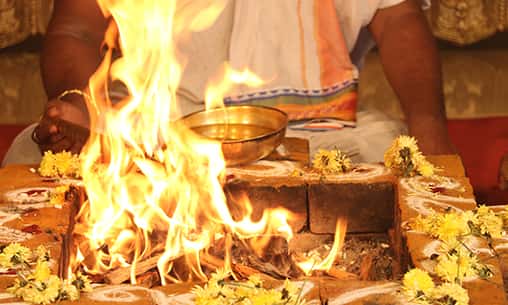Homam is a ritual in Hinduism that people perform to please a deity and manifest a specific desire. This technique came to us from ancient sages who had attained enlightenment and spiritual masters of India. For instance, one can perform a Homam to gain wealth, recover from ailments, get married, or for progeny blessings. During a Homam, priests chant Vedic Mantras and offer many things to the sacrificial Fire. Homams are also called Yagnas or Havans.
In Homam, a sacred fire is invoked with the aim of cleansing the self (material and spiritual) as well as the environment. The Fire represents God, and people offer items like grains, ghee, and herbs to the Fire as symbolic offerings to the deity invoked. This ritual can revitalize and purify the environment and even cure diseases.
The main step in a Homam procedure is to start and maintain the sacred Fire. The chanting of Mantras is another component. There are many kinds of Homams to invoke various deities for certain purposes. The ingredients used for the Homam include dried cow dung patties, wood shavings, dried coconut, peepal twigs (samit), camphor, curd, milk, and ghee.
Fire is holy in Hinduism. It is the subtlest element that we can see with our eyes. So, it is the ideal medium to invoke God.

The Importance of Agni
The Rig Veda speaks of the supreme position of Agni, who is the foremost Purohit. Agni has the first place in worship before the Homa begins. Agni burns past sins and ignorance, leading us towards the divine light. Along with Indra and Soma, Agni too, is highly revered by the residents of the 3 worlds. He can be in the 3 spaces in 3 forms. He is Fire on earth, lightning in the atmosphere, and the Sun in the sky. This makes him the central figure and the messenger between the gods and the humans. He carries the wishes of the humans to the gods.
There are 2 forms of Agni/Fire in the human body – Jatara-agni (digestive Fire) and Bhoota-agni (spiritual Fire). It is Bhoota-agni that can sustain divinity. When yogis make offerings to a god, the deity will be able to enter into the Bhoota-agni and receive the offering.
But Bhoota-agni is weak in normal human beings. So, we need an external fire to invoke the deity so that the deity can directly receive the offerings from the external Fire. The deity then fulfills our righteous desires.
The Science of Homa
During the Homam, the priest first meditates on the deity and energizes the space. The chanting of Mantras helps transfer this energy to the air element. This, in turn, energizes the Fire in the Homa Kunda (sacred fire receptacle). The energy created in the Fire is then transferred to the water in the Kalaash (water pots). When the water is sprinkled or poured on us or the deity, it transfers the entire energy to earth.
The priest invokes the presence of the deity through certain Mantras. Once it is energized, the Fire itself becomes a deity till the end of the Homa. The deity is then worshipped, and many oblations (ahuti) are offered into the Fire to manifest one’s desire. The smoke that comes from the Homa kunda energizes the entire space where the Homam is performed. It purifies the place and creates positive vibrations.
Homas can have positive effects not only on the people who are physically present during the Homam but also on those whose names have been chanted in the Sankalpa Mantra, even if they happen to be far away from the Homa site. The energy that is built up in the Homa fire reaches the participant and helps manifest the participant’s desires.
Of all the prescribed Vedic rituals, Homam is the fastest way to gain divine blessings.
One can get instant Homa services or perform Instant Homam online nowadays at the click of a button.
